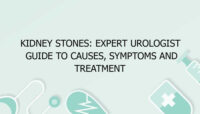Cholesteatoma is a chronic ear condition marked by the abnormal growth of skin cells in the middle ear. This condition can lead to a range of symptoms and complications if not managed effectively. In this comprehensive guide, we will delve into the symptoms, causes, and treatments for cholesteatoma, providing valuable information for those seeking to understand or address this condition.
Understanding Cholesteatoma
What is Cholesteatoma?
Cholesteatoma is an abnormal accumulation of skin cells and other debris in the middle ear. This growth forms a sac or cyst that can erode the surrounding structures of the ear. Over time, cholesteatoma can cause significant damage to the ear and affect hearing. It is important to recognize the symptoms early to prevent further complications.
Symptoms of Cholesteatoma
1. Persistent Ear Discharge
One of the hallmark symptoms of cholesteatoma is a persistent ear discharge. This discharge is often foul-smelling and may be accompanied by a sensation of fullness or pressure in the ear. The discharge can vary in consistency, ranging from thick and sticky to watery. This symptom is particularly noticeable when the cholesteatoma is left untreated, as the discharge may become more frequent and profuse.
2. Hearing Loss
Hearing loss is another common symptom associated with cholesteatoma. The abnormal growth in the middle ear can interfere with the bones responsible for conducting sound, leading to conductive hearing loss. This type of hearing loss occurs when sound waves are not efficiently transmitted through the outer ear to the inner ear. As the cholesteatoma progresses, the hearing loss may become more pronounced.
3. Ear Pain and Discomfort
Patients with cholesteatoma may experience varying degrees of ear pain or discomfort. This pain can range from mild to severe and may be constant or intermittent. The discomfort is often accompanied by a feeling of pressure in the affected ear. As the condition advances, the pain may become more intense and persistent.
4. Dizziness and Balance Issues
In advanced cases of cholesteatoma, patients may experience dizziness or balance problems. This occurs when the abnormal growth affects the inner ear structures, which are responsible for maintaining balance. Dizziness and balance issues can significantly impact daily activities and quality of life.
5. Facial Weakness
Although less common, cholesteatoma can lead to facial weakness or paralysis. This happens when the growth exerts pressure on the facial nerve, resulting in drooping or weakness on one side of the face. Facial weakness is a serious symptom that requires immediate medical attention.
Causes of Cholesteatoma
1. Chronic Ear Infections
Chronic ear infections are a primary cause of cholesteatoma. Recurrent infections can lead to the formation of a persistent sac or cyst in the middle ear, which may eventually develop into a cholesteatoma. These infections often result in inflammation and damage to the ear structures, creating conditions favorable for cholesteatoma formation.
2. Eustachian Tube Dysfunction
The Eustachian tube helps equalize pressure in the middle ear. When this tube does not function properly, it can lead to negative pressure and fluid accumulation in the middle ear. This environment can contribute to the development of cholesteatoma. Eustachian tube dysfunction can be caused by allergies, respiratory infections, or anatomical abnormalities.
3. Congenital Factors
In some cases, cholesteatoma is present from birth due to congenital factors. This type of cholesteatoma is less common but occurs when there is an abnormal development of the ear structures during fetal development. Congenital cholesteatoma requires early diagnosis and treatment to prevent complications.
4. Previous Ear Surgery
Ear surgeries, such as tympanoplasty or mastoid surgery, can sometimes lead to cholesteatoma development. Post-surgical changes or complications can create an environment that facilitates the growth of cholesteatoma. Patients who have undergone ear surgery should be monitored closely for signs of cholesteatoma.
Treatment for Cholesteatoma
1. Surgical Removal
Surgery is the primary treatment for cholesteatoma. The procedure involves removing the cholesteatoma and any damaged tissue from the middle ear and surrounding structures. The surgeon may also repair any damaged ear structures to restore hearing and prevent recurrence. The type of surgery performed depends on the extent of the cholesteatoma and the involvement of other structures.
2. Antibiotic and Antiseptic Treatment
In cases with active infection, antibiotics and antiseptics are prescribed to manage the infection and reduce inflammation. This treatment is often used in conjunction with surgery to address the infection and prevent further complications. Proper antibiotic use is crucial to effectively manage the infection and promote healing.
3. Hearing Aids
If cholesteatoma has resulted in significant hearing loss, hearing aids may be recommended to improve auditory function. Hearing aids can amplify sound and enhance communication, particularly if there is residual hearing loss after surgery. A hearing specialist can help determine the most appropriate hearing aid for each individual.
4. Follow-Up Care
After cholesteatoma surgery, follow-up care is essential to monitor the healing process and ensure that the cholesteatoma does not recur. Regular check-ups with an ear, nose, and throat (ENT) specialist are necessary to assess the condition of the ear and address any potential issues. Follow-up care helps ensure a successful recovery and minimizes the risk of complications.
5. Management of Complications
In cases where cholesteatoma has caused complications such as facial weakness or balance issues, additional treatments may be required. This may include physical therapy, rehabilitation, or further surgical interventions to address the complications and restore function. Managing complications effectively is crucial for achieving the best possible outcome.
Frequently Asked Questions About Cholesteatoma
1. What is cholesteatoma?
Cholesteatoma is an abnormal growth of skin cells and other debris in the middle ear. It forms a sac or cyst that can erode surrounding ear structures and cause symptoms such as ear discharge, hearing loss, and pain.
2. What are the symptoms of cholesteatoma?
Symptoms of cholesteatoma include persistent ear discharge, hearing loss, ear pain or discomfort, dizziness or balance issues, and in rare cases, facial weakness.
3. How is cholesteatoma diagnosed?
Cholesteatoma is diagnosed through a combination of medical history, physical examination, and imaging tests such as CT scans or MRI. An ENT specialist will examine the ear and perform tests to assess hearing and evaluate the extent of the growth.
4. What causes cholesteatoma?
Cholesteatoma is caused by factors such as chronic ear infections, Eustachian tube dysfunction, congenital factors, or previous ear surgeries. These factors create conditions that facilitate the growth of cholesteatoma in the middle ear.
5. How is cholesteatoma treated?
Treatment for cholesteatoma typically involves surgical removal of the growth, management of infections with antibiotics, and follow-up care to monitor for recurrence. Hearing aids may be used to address any residual hearing loss.
6. Is cholesteatoma cancerous?
No, cholesteatoma is not cancerous. It is a benign growth of skin cells in the middle ear. However, if left untreated, it can cause significant complications and damage to ear structures.
7. Can cholesteatoma be prevented?
While it may not be possible to prevent all cases of cholesteatoma, managing chronic ear infections and maintaining good ear health can help reduce the risk. Addressing Eustachian tube dysfunction and seeking prompt treatment for ear infections are also beneficial.
8. What are the potential complications of cholesteatoma?
Potential complications of cholesteatoma include hearing loss, dizziness, facial weakness, and damage to surrounding structures such as the inner ear or brain. Early diagnosis and treatment are essential to prevent these complications.
9. How long does recovery from cholesteatoma surgery take?
Recovery time after cholesteatoma surgery varies depending on the extent of the procedure and individual factors. Most patients can expect a recovery period of several weeks to a few months. Follow-up appointments are necessary to monitor healing and ensure proper recovery.
10. Can cholesteatoma recur after treatment?
Yes, cholesteatoma can recur after treatment, especially if the initial growth was extensive or if underlying issues were not fully addressed. Regular follow-up care with an ENT specialist is crucial to monitor for signs of recurrence and manage any potential issues.


